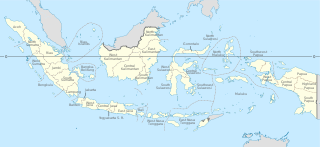
Provinces are the first-level administrative divisions of Indonesia. It is formerly called the first-level provincial region provinsi daerah tingkat I) before the Reform era. Provinces have a local government, consisting of a governor and a regional legislative body. The governor and members of local representative bodies are elected by popular vote for five-year terms, but governors can only serve for two terms. Provincial governments have the authority to regulate and manage their own government affairs, subject to the limits of the central government.
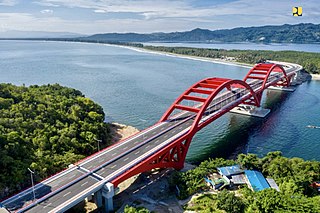
Jayapura is the capital and largest city of the Indonesian province of Papua. It is situated on the northern coast of New Guinea island and covers an area of 940.0 km2 (362.9 sq mi). The city borders the Pacific Ocean and Yos Sudarso Bay to the north, the country of Papua New Guinea to the east, Keerom Regency to the south, and Jayapura Regency to the west.
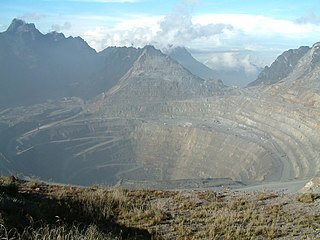
The Grasberg mine has one of the largest reserves of gold and copper in the world. It is located in Mimika Regency, Central Papua, Indonesia near Puncak Jaya. It is operated by PT Freeport Indonesia, a joint venture between the government of Indonesia, government of Papua, and American company Freeport-McMoRan (FCX).

Western New Guinea, also known as Papua, Indonesian New Guinea, and Indonesian Papua, is the western, Indonesian half of the island of New Guinea. Since the island is alternatively named Papua, the region is also called West Papua.

Sorong is the largest city and the capital of the Indonesian province of Southwest Papua. The city is located on the western tip of the island of New Guinea with its only land borders being with Sorong Regency. It is the gateway to Indonesia's Raja Ampat Islands, species rich coral reef islands in an area considered the heart of the world's coral reef biodiversity. It also is the logistics hub for Indonesia's thriving eastern oil and gas frontier. Sorong has experienced exponential growth since 2010, and further growth is anticipated as Sorong becomes linked by road to other frontier towns in Papua's Bird's Head Peninsula.

Indramayu, named after the God Indra, is a town and district which serves as the capital of Indramayu Regency in the West Java province of Indonesia, and is located in the northern coastal area of West Java, east from Jakarta, north-east from the city of Bandung, and north-west of the city of Cirebon. Most of its land are situated below sea level, which makes the district vulnerable to high tide in stormy conditions. The district is only protected by some dunes and barrages at the seaside.

Sorong Regency is a regency of the Southwest Papua province of Indonesia. It covers an area of 13,075.28 km2, and had a population of 70,619 at the 2010 Census, and 118,679 at the 2020 Census; the official estimate as of mid-2022 was 125,949. Its administrative centre is the town of Aimas. Sorong Regency surrounds Sorong City (Kota) on the landward side; the city is administratively independent of the Regency and is not included in the above statistics; Sorong City has an airport, Sorong Airport, which also serves the Regency.
Wamena, also known as the District of Wamena, is a large town in the Western New Guinea region of Indonesia. It also serves as the seat of Jayawijaya Regency. It is the largest town in the province of Highland Papua, located in the Baliem Valley and had a population of 64,967 in the 2020 Census; the official estimate in mid 2022 was 65,766. Wamena is the urban centre of a rural area housing Highland Papua's highest concentration of population, with over 300,000 people inhabiting the Baliem Valley and surrounding areas. These people belong to several related ethnic groups, the most prominent of which are the Dani, Lani, and Yali.

Puncak Jaya Regency is one of the regencies (kabupaten) in the Indonesian province of Central Papua. It is an inland highland regency, lying directly east of Paniai Regency and west of Jayawijaya Regency and Tolikara Regency. As of 2004, it was reported that these four regencies had a population that is 93–97% ethnic Papua; however this included areas which have subsequently been formed into new regencies.

Mimika Regency is one of the regencies (kabupaten) in the Indonesian province of Central Papua. It covers an area of 21,693.51 km2, and had a population of 182,001 at the 2010 Census, but grew to 311,969 at the 2020 Census. The official estimate as of mid-2022 was 321,657. The administrative centre is the town of Timika, which lies within Mimika Baru District, which had 144,893 inhabitants in mid-2021.

Kelly Kwalik was a senior separatist leader and military commander with the Free Papua Movement (OPM), a separatist organization based in Indonesia's Papua Province.
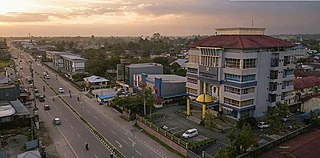
Timika is a chartered city (kota), and the capital of Mimika Regency on the southern coast of Central Papua, Indonesia. At the 2020 Census, the district which includes the town had a population of 142,909.
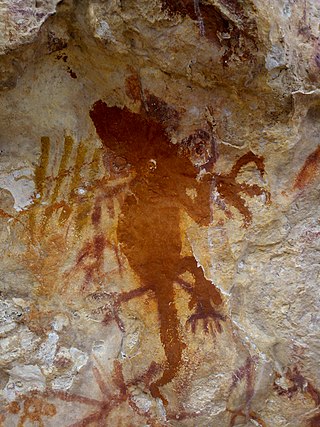
Kaimana is a district and a small port town in West Papua, Indonesia and capital of the Kaimana Regency. The district had a population of 44,332 in mid 2022, while the town had 16,718 and Krooy had 12,416 inhabitants.

Tambrauw Regency is a regency of Southwest Papua Province, Indonesia, in the Bird's Head Peninsula of Papua Island. It was created on 29 October 2008 from what had been an eastern part of Sorong Regency, originally as part of the province of West Papua.

Kuala Kencana is a district in Mimika Regency, Central Papua, Indonesia. It is the purpose-built company town, managed by Indonesian mineral extraction company PT Freeport Indonesia. The new town was inaugurated by Indonesian President Suharto in 1995. The district covers an area of 860.74 km2 and had a population of 18,290 at the 2010 Census and 27,774 at the 2020 Census.
Ransiki is a town in Indonesia province of West Papua, at the western end of New Guinea. The town is the administrative seat of the South Manokwari Regency. In 2010, there were 7,683 people in Ransiki, which rose to 16,245 at the 2020 census. The town is served by Ransiki Airport.
Kepi is a town in Mappi Regency, South Papua, Indonesia. Following the formation of Mappi Regency in 2002, the town became its administrative seat.

Central Papua, officially the Central Papua Province is an Indonesian province located in the central region of Western New Guinea. It was formally established on 11 November 2022 from the former eight western regencies of the province of Papua. It covers an area of 61,072.92 km2 and had an officially estimated population of 1,430,951 in mid 2022. It is bordered by the Indonesian provinces of West Papua to the west, the residual province of Papua to the north and northeast, by Highland Papua to the east. and by South Papua to the southeast. The administrative capital is located in Wanggar District in Nabire Regency, although Timika is a larger town.

Highland Papua is a province of Indonesia, which roughly follows the borders of Papuan customary region of Lano-Pago, shortened to La Pago. It covers an area of 51,213.34 km2 (19,773.58 sq mi) and had a population of 1,430,459 according to the official estimates as at mid 2022.


















